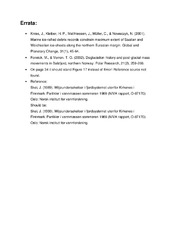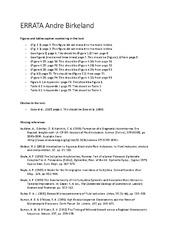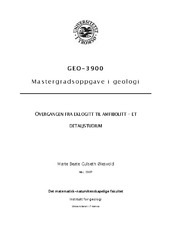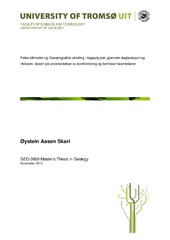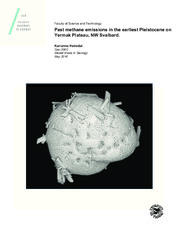Blar i tittel Mastergradsoppgaver i geologi
Viser treff 151-170 av 271
-
Natural and anthropogenic deposition in Bøkfjorden
(Master thesis; Mastergradsoppgave, 2018-05-15)The aim for this study is to characterise and distinguish natural and anthropogenic deposition in Bøkfjorden, and to identify the spreading and the impact of submarine tailings placements on the seafloor. The analyses are based on the integration of swath bathymetry, high-resolution seismics and multi-proxy analyses of four sediment cores The physical properties, including magnetic susceptibility ... -
Neoglacial plateau ice cap behaviour in Central Spitsbergen constrained by subglacially preserved vegetation.
(Mastergradsoppgave; Master thesis, 2021-06-15)Cold-based glacial ice is well known to preserve underlying landforms produced by earlier processes but can also preserve pre-existing organic material and vegetated ground. With current rapid climate warming, overall glacier retreat in the Arctic is exposing formerly ice-buried in situ vegetation at the margin of cold-based ice bodies. Radiocarbon dating of this vegetation constrains the timing of ... -
The Nussir copper deposit: petrology, mineralogy, geochemistry and distribution of ore mineralization
(Master thesis; Mastergradsoppgave, 2013-06-28)The geology, petrography, mineralogy and geochemistry of the Nussir copper deposit in Finnmark, Northern Norway were studied during writing this thesis. The Nussir deposit of copper is a sedimentary-hosted hydrothermal deposit affected by low grade methamorphism and ductile deformation. The copper mineralization includes chalcopyrite, chalcocite, bornite, covellite, and digenite. The deposit contains ... -
Occurence of free gas and focused fluid systems in the Veslemøy High area, SW Barents Sea
(Master thesis; Mastergradsoppgave, 2009-05-15)The high-resolution 3D seismic survey EL0001 allowed to document the subsurface fluid migration system and fluid accumulations within Veslemøy High, SW Barents Sea. Fluids migrate both through Cretaceous and Tertiary sediments, but also through younger glacial sediments. Veslemøy High is a structurally isolated high at the Cretaceous and Tertiary levels bounded by N-S trending west-dipping normal ... -
The occurrence of flow transformations within sandy submarine fans: A case study from the Eocene on Spitsbergen
(Master thesis; Mastergradsoppgave, 2017-05-15)The Van Keulenfjorden transect on Spitsbergen offers valuable insight into submarine processes, with well exposed seismic scale clinoforms of Paleocene and Eocene age, which show the distribution of sediments from deltaic to basin floor environments. Several progradational submarine fans are preserved as cliffs on Hyrnestabben. They serve as an analogues to coarse grained submarine fans in provinces ... -
Onshore-offshore correlation in the Andfjorden area and the structural controls on the opening and evolution of the Mesozoic sedimentary basins on Andøya and Andfjorden, northern Norway
(Master thesis; Mastergradsoppgave, 2014-05-14)Onshore-offshore correlation of brittle faults has been undertaken in the Andfjorden area defining the boundary between the passive Lofoten-Vesterålen margin and the transform SW Barents Sea margin. This study has focused its efforts on onshore mapping of faults and fractures, the mapping of offshore faults and associated basin-ridge systems from seismic interpretation and the link between fault ... -
Ore petrography and fluid evolution in the Cu-(Zn) VMS deposits at Sulitjelma, Northern Norway
(Master thesis; Mastergradsoppgave, 2018-05-29)The Sulitjelma deposits, Nordland, Northern Norway, with more than 20 Zn-Cu ore bodies (total tonnage excesses 35 Mt of ore at 1.84 % Cu, 0.86 % Zn, 10 g/t Ag and 0.25 g/t Au) have been described as a classic example of the Zn-Cu volcanogenic massive sulfide (VMS) mineralization. The mineralization is spatially associated with metamorphosed mafic rocks of Ordovician age. Both, ore bodies and their ... -
Origin and Economic Potential of Lithium-mineralized Granitic Pegmatites in Helgeland, North Norway
(Mastergradsoppgave; Master thesis, 2023-08-04)A comprehensive set of analytical techniques, encompassing geological, petrographic, mineralogical, and zircon U-Pb-Hf isotopic compositions, was employed to investigate a relatively poorly known pegmatite field located in Helgeland, North Norway. The Paleoproterozoic basement gneisses in the area have U-Pb zircon crystallization ages between 1870 ± 12 and 1811 ± 6 Ma, meaning that they belong to ... -
The origin of quartz-carbonate veins hosted by ductile shear zones of the Astridal Supracrustal Belt, West-Troms Basement Complex.
(Master thesis; Mastergradsoppgave, 2018-05-29)An approximately 1 meter wide NE-SW-oriented mylonitic shear zone hosts hydrothermally precipitated quartz and carbonate veins. The shear zone mainly consists of a secondary mylonitic fabric enriched in chlorite. A similar mylonitic shear zone striking NE-SW, oriented parallel to the axial plane of a F3-fold, consists of the same secondary mylonitic chloritized fabric and are therefore assumingly ... -
Overgangen fra eklogitt til amfibolitt. Et detaljstudium
(Master thesis; Mastergradsoppgave, 2007-05)Formålet med oppgaven er å gjøre en systematisk petrografisk og petrologisk undersøkelse av en mafisk linse med omgivende granat-glimmerskifer/marmor innen Tromsødekket. Den mafiske linsa har opprinnelig sannsynlig vært en basaltisk gang/sill som har blitt metamorfosert under eklogittfacies. Lokaliteten er blottlagt i ei veiskjæring ved universitetet i Tromsø (UiT). Den valgte mafiske linsa har en ... -
Palaeoceanographic and climate changes during the Holocene in Hinlopen Strait, northern Svalbard
(Mastergradsoppgave; Master thesis, 2023-05-20)This study investigates the paleoceanographic changes in the Hinlopen Strait, situated between Spitsbergen and Nordaustlandet, through a multi-proxy analysis of sediment core HH15-1280-GC (439 m water depth). Located near the Polar Front, this region is highly sensitive to even minor alterations in the ocean circulation and climate, which can be reconstructed from marine sediment records. The core ... -
Palaeoceanographic development in Leirdjupet Trough, western Barents Sea, during the Holocene: evidence from foraminiferal, isotopic and sedimentological records
(Master thesis; Mastergradsoppgave, 2015-12-14)The gravity core HH14-012GC from Leirdjupet Trough has been investigated to detect changes in sedimentation and the variations in distribution patterns of marine microorganisms (Planktic and Benthic Foraminifera) and stable isotope values of their shells to reconstruct the variability of the inflow of Atlantic water to the study area. The results are compared to published paleodata records to ... -
Paleo-klimatisk og oseanografisk utvikling i Ingøydjupet, gjennom deglasiasjon og Holosen, basert på undersøkelser av kornfordeling og bentiske foraminiferer
(Master thesis; Mastergradsoppgave, 2013-11-21)To kjerner fra Ingøydjupet i sørvest Barentshavet, 11HH-152MC og JM06-012GC, er blitt undersøkt for å undersøke den paleo-klimatiske og paleo oseanografiske utviklingen i Barentshavet. Dette er rekonstruert basert på undersøkelser av bentiske foraminiferer og kornfordeling. Kjernenes lengde er på henholdsvis ca 50 cm og 200 cm og 3 radiokarbon dateringer ligger til grunn for alderskronologien. ... -
Paleoceanographic development during the last deglaciation and Holocene, over the Bear Island slide scar, SW Barents Sea
(Master thesis; Mastergradsoppgave, 2017-02-02)The investigated sediment core HH13-243 GC is located under the present flow of the warm and saline Atlantic Water (AW), but close to, glaciated continental margins. The core site is situated in an area that is sensitive to changes and reflects the paleoceanography of the northernmost Norwegian Sea and the Western Barents Sea. We investigated the changes in inflow of Atlantic water and the ... -
Paleoceanographic development in Leirdjupet, during the last deglaciation
(Master thesis; Mastergradsoppgave, 2016-08-23)The focus of this master thesis is to investigate the paleoenvironmental and paleoceanography during the last deglaciation in Leirdjupet, a small submarine trough in the southwestern Barents Sea. The lower half of the piston corer HH15-1303PC has been investigated for the distribution pattern of benthic foraminifera faunas, ice rafted debris (IRD), lithology and oxygen and carbon isotopes covering; ... -
Paleoceanographic Development in Nordfjord, North East Greenland, During the Mid- and Late Holocene
(Master thesis; Mastergradsoppgave, 2017-05-15)Sediment core HH13-012GC-TUNU, retrieved from Nordfjord, North-East Greenland, has been investigated in order to reconstruct the paleoceanographic development during the mid- and late Holocene. Nordfjord is one of three tributary fjords to Kaiser Franz Joseph Fjord, and Waltershausen Gletcher is located at its head. The fjord system is largely influenced by the Eastern Greenland Current. Most of ... -
Paleoenvironmental investigation of the northern flank of the Olga Basin (Barents Sea) during the Late Weichselian deglaciation
(Master thesis; Mastergradsoppgave, 2018-06-11)Three gravity cores were collected from an unexplored site in the northern flank of the Olga Basin, Barents Sea. The lack of data from the central Barents Sea prompted this investigation and led to defining the evolution of the environment and ice sheet transitions over the Holocene. The three cores underwent benthic foraminiferal studies in combination with stable isotope analysis of (δ18O and δ ... -
Past methane emissions in the earliest Pleistocene on Yermak Plateau, NW Svalbard.
(Master thesis; Mastergradsoppgave, 2016-05-15)Hole 912A (Ocean Drilling Program (ODP) Leg 151) drilled on the Yermak Plateau (eastern Arctic Ocean) is used to investigate past methane emissions in the earliest Pleistocene. Preliminary work showed depleted δ¹³C values at 93-96 meters below sea floor (mbsf), and an increase in methane concentration between 11, 5 and 23 mbsf. A secondary sampling focused on intervals between 10 and 23 mbsf (core ... -
Petrogenesis and tectonic setting of the mafic-ultramafic rock association from NW Senja, West Troms Basement Complex
(Master thesis; Mastergradsoppgave, 2013-01-31)The studied mafic-ultramafic rock association occurs within Archean tonalitic gneisses and metasupracrustal suites of the Astridal belt belonging to the West Troms Basement Complex in the northwestern part of the Senja Island. The rock association appears in lens-shaped bodies, up to 200 m long, which are oriented conformal to the major metamorphic fabric of the host rock. The rock association is ... -
Petrographic investigation of methane-derived authigenic carbonate crusts from Barents Sea and Norwegian Sea
(Master thesis; Mastergradsoppgave, 2016-06-15)Methane-derived authigenic carbonate crusts from four seepage sites at the Loppa High in the southwestern Barents Sea, and one seepage site at Hola, off Vesterålen in the Norwegian Sea, have been investigated, with the main focus of understanding if and how the tests of benthic and planktonic foraminifera occurring in the crusts could serve as nucleation centers for the precipitated carbonates.


 English
English norsk
norsk